If you’ve been a technician in this field for more than 15 years, you’re probably familiar with an almost forgotten rear replacement procedure called rear full body sectioning (or, as we called it until “60 Minutes” and “20/20” came onto the scene, rear clipping). Though in recent years the technique has lost favor with most insurers, technicians and shop owners, it shouldn’t be forgotten. In fact, it can still be the best method to use on many damaged vehicles.
For this article, we’re going to look at the pros and cons of rear full body sectioning, why it lost its “favorable” status and when it can be the best repair method. We’ll also walk you through the process on a late-model Ford Focus, compliments of Toby Chess, another contributing editor of BodyShop Business and a good friend. This article, however, isn’t intended to be a “how to.”
Our focus here is on what’s involved with the procedure and why it’s not performed very often these days.
What Is Full Body Sectioning?
This procedure is normally more commonly used when damages to the rear of the vehicle would require extensive rear floor replacement/repair along with the rear frame rails, one or both rear quarter panels, the rear body panel and the rear outer cosmetic panels. These types of damages often start the “total loss” calculators buzzing while, unfortunately, making unqualified “rebuilders” salivate.
This has always been a concern for me over the years, since our industry has the properly trained technicians and the equipment to restore the vehicle back to pre-accident condition – while the typical rebuilder often hasn’t received proper training on welding, high-strength steel or sectioning techniques. The average rebuilder gets it done any way he can, contains costs and may even sacrifice proper procedures to maintain his profit on the job since it’s related to his selling price of the vehicle, not an agreed to repair price.
Insurers also seem to be content to allow higher salvage bids by these “rebuilders” to affect the threshold for totaling the vehicle – even though, at some point, the same vehicle may be placed back in service (on the road again) in an unsafe condition and be re-insured. It’d be very interesting to track these vehicles in case of another accident and determine their crashworthiness – and if the prior repair was linked to additional damages or injuries. (We’ll examine more reasons why this happens later.)
The actual location for replacement at the roof panel and floor panel can vary due to the extent of the damages and the type of vehicle. In this particular repair, we’re sectioning in the sail panels, which many have termed a “short clip.” See photo below.
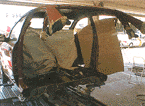
In addition, we’re sectioning the floor at a factory seam, as shown below.
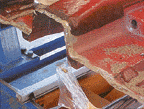
Many of you may remember that another commonly taught location to section this vehicle would be at the A-Pillars (windshield posts) and possibly through the B-Pillars (center posts). In fact, the floor was often seamed through the front door openings, so the B-Pillars would remain intact. The floor seam in these types of sectioning areas would be accomplished with an overlapping welded joint, with the joint underside overlapping toward the rear. This was the original I-CAR-tested sectioning procedure done by MGA Research of Buffalo, N.Y., released in the mid to late 1980s.
In our example here, the damages don’t warrant the destruction of additional factory welds, and the repair can be localized to the rear door openings. Plus, with a greater emphasis being placed on an “invisible repair” to eliminate repair diminished value, using the factory floor seams is a more preferred method.
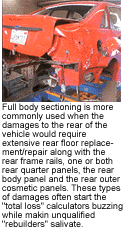
It’s also timely to note that full body sectioning isn’t recommended to the front section of the vehicle if it includes replacing the cowl panel, which includes the vehicle identification number (VIN), engine and/or drive train. This, of course, is due to the difficulty with ensuring comparable conditions of engine, drive train components, associated electronics and vehicle options. The transfer of the VIN from one vehicle to another also carries a list of activities for which each state has specific rules and regulations.
However, replacing complete front structural sections attached to the original cowl panel or to a recommended sectioning location is an acceptable repair procedure to consider for the correct situation.
The Pros – It’s a Beautiful Concept
In many situations, full body sectioning is the best repair method to consider. Why?
- Less disturbance to factory welds and corrosion protection.
- Less parts delays.
- Utilization of OEM parts and recycling at the same time.
- Time savings.
1. Less disturbance – On our vehicle, there’s extensive damage to the floor panel, frame rails, rear body panel, right quarter panel, and inner and outer wheel houses. If you calculated the number of plug and spot welds it would require to replace these components with new OEM parts individually, it could easily be between 500 and 1,000 welds.
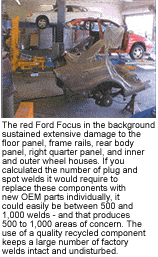
That produces 500 to 1,000 areas of concern that must be considered, such as properly applying corrosion protection, properly performing welds and providing a warranty. The use of a quality recycled component, however, keeps a large number of factory welds intact and undisturbed (rear floor panel, frame rails, rear body panel, quarter panels and inner wheel houses).
I have no doubt that we can produce welds and restore proper corrosion protection in these areas when we produce every weld individually, part by part. But the point is that using a quality recycled component eliminates the need to do so in many areas. What would you rather be responsible for: 750 individual areas or less than 100? I’d certainly choose the latter.
2. Less parts delays – The location of a quality recycled component almost eliminates the parts delays associated with inner structure pieces. “The little support brackets that the manuals don’t show” always come to mind because they need to be special ordered, take weeks to receive and tie up the vehicle and the production stall day after day.
In most cases, the really hard-to-get parts come with the quality recycled component. In fact, the little things like clips, brackets and even inner trim pieces are usually included. What a deal!
3. Utilization of OEM, recycled parts – The quality recycled component is most likely all OEM, and we’re doing the right thing by recycling. Even Ford Motor Company has recognized the value of recycling and in their recent initiatives, will be increasing their involvement in recycling yards and salvage part sales. (Check out www.GreenLeafAuto.com.)
4. Time savings – Finally, being able to lessen the number of parts installed individually will decrease the time the job requires. (I haven’t forgotten the preparation of the quality recycled component. It comes in the next section.)
Reducing downtime for parts and the number of welds required can improve cycle time dramatically. In many cases, I’ve seen the full body sectioned vehicle completed before many other vehicles – which were still waiting for individual parts to come in.
The Cons – When Concept Becomes Reality
Now to the other side of the story. There are a number of reasons why this procedure isn’t performed. Some of the reasons are to be expected – since the total repair bill will often be approaching that “total loss threshold.” This will certainly influence the decision to just total the vehicle and get on to another claim.
I’ve reduced the main reasons why this procedure is rarely done to three main areas.
- Lack of immediate availability of a quality recycled component.
- Lack of incentive to perform this procedure.
- Lack of technical skill and equipment to perform properly.
1. Lack of availability – When you decide to use this procedure, timing is important. The needed quality recycled component needs to be available for a competitive price, from a trusted location and in a timely manner. Everyone has experienced the, “Yeah, we got one. Just has some minor ‘cleanup’ damage to the left quarter.” But when it gets there a week late, it’s just as bad as what you’re cutting off! If this happens just a few times, it quickly becomes a reason not to recommend using this procedure.
I suggest reviewing my article “The Parts Debate,” in the October 1998 issue of BodyShop Business about the use of recycled parts and how they can assist in reducing costs, improving cycle time and increasing profit. In this article, I also explained what could be done by recyclers to increase recycled parts usage. These are the areas that can be part of the “cons” if not done.
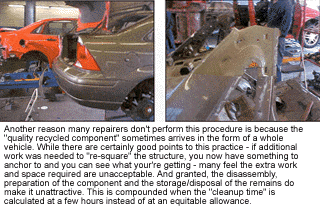
I realize that much is happening to ensure quality recycled components are accurately inventoried, catalogued and available when requested. This could easily include digital images for the ordered recycled component for verification by the buyer.
But keep in mind that if we need a complete rear full body section, the search can become more difficult. Why? The component is available in a salvage yard because the vehicle was deemed unrepairable (even to a rebuilder), so it probably was hit pretty hard somewhere. The nature of a unitized body is to transfer energy throughout the structure during impact. This makes damage likely to the front door opening and roof panel areas. Now you’re fixing two vehicles, not just one.
There are obviously other reasons the vehicle may be deemed a total loss such as theft, vandalism and water damage. Each may cause additional work to use the part or may even be a deciding factor in not using it.
2. Lack of incentive – A major stumbling block for using this procedure is often a lack of incentive. This lack of incentive begins with the times suggested by “used assembly guides” – times that are lean (bordering on ridiculous) and usually don’t incorporate all the additional operations necessary to complete the job. For this reason, many shop owners and technicians won’t consider it because it isn’t worth the hassle.
In our example, the original estimate was bordering a total loss threshold of approximately $11,000. Once the agreement was made to perform a full body “short” section, the total cost of the job decreased to under $8,000, with approximately 100 metal units available. Not bad for a week’s work.
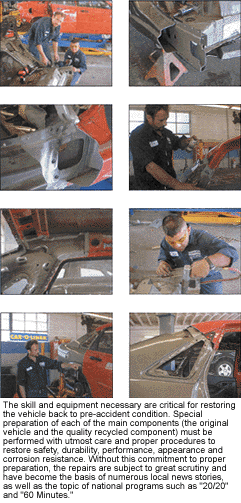
Another problem for some begins when the “quality recycled component” arrives in the form of a whole vehicle. There are certainly good points to this common practice. For example, if some additional work was needed to “re-square” the structure, you now have something to anchor to and you can see what you’re getting. Still, many feel the extra work and space required are unacceptable. And granted, the disassembly, preparation of the component and the storage/disposal of the remains do make it unattractive. This is compounded when the “cleanup time” is calculated at a few hours instead of at an equitable allowance.
3. Lack of technical skill and equipment – This is a very important concern. As mentioned earlier, rebuilders may have never received any training on how to work with structural reinforcements, proper welding preparation procedures, and the measuring and welding required. This same situation may also occur in a collision repair facility. Even though training has been available since the early 1980s, proper procedures certainly haven’t been embraced by all of our industry members.
The skill and equipment necessary are critical for restoring the vehicle back to pre-accident condition. Special preparation of each of the main components (the original vehicle and the quality recycled component) must be performed with utmost care and proper procedures to restore safety, durability, performance, appearance and corrosion resistance. Without this commitment to proper preparation, the repairs are subject to great scrutiny and have become the basis of numerous local news stories, as well as the topic of national programs such as “20/20” and “60 Minutes.” For this reason alone, many shop owners, technicians and insurers elect not to perform this procedure.
When It’s the Right Procedure

Let’s look at this for a moment from the customer’s point of view. There’s no doubt that the media has demonstrated the “worst of the worst” in these situations, and many consumers have formed strong perceptions about major vehicle repairs. That’s what TV sensationalism is supposed to do. Otherwise, the ratings would dwindle. But it doesn’t make it true or a standard for an entire industry.
In this case, let’s assume the customer has leased his vehicle and it’s one year old at the time of the accident. He also has the normal insurance coverage (no gap protection) and put very little down when he leased it. At the time of the accident, the value of the vehicle is most likely thousands of dollars less than his financial obligation to the leasing company or bank.
If the vehicle is deemed a total loss, some very creative “roll over costs” will need to be transferred to the new loan or lease, which increases his payment amount and/or payment length significantly. This also increases the risk to the customer. And what does he do if this happens again?
When communicating with the customer, suggest rear full body sectioning as a positive option, provided a proper repair is authorized. This would ensure he doesn’t have repair or insurance diminished value problems when he does elect to trade or sell the vehicle. (Since I believe inherent diminished value isn’t real but, rather, a result of repair diminished value over time to an uneducated consumer and a self-serving fabrication of the legal industry, it’s not part of this discussion.) This procedure can save the vehicle and also save the customer excessive out-of-pocket expenses.
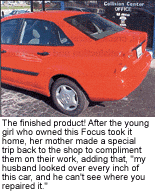
Even with all this in mind, it’s common for insurers and customers not to authorize this procedure based on a number of the “cons” I wrote about and on unwarranted perceptions. Some insurers have provided written positions on this, while others will comment only verbally. It may be as simple as the liability risk they feel they’re taking isn’t worth the possible outcomes.
Even though insurers aren’t performing the work themselves, being the party with the biggest pockets can easily cost them a great deal of money in legal fees and unsatisfied customers, which could lead to losing policyholders. Oftentimes, the hassles we endure to perform this procedure make us forget what we can really do if allowed.
It’s All About Restoring the Vehicle to Pre-Accident Condition
Have you noticed the number of vehicles being totaled increasing or decreasing? From our observations, it’s increasing – and continuing to do so. And some of those jobs may be the jobs you need to keep your shop operating at peak performance.
Even though special planning and skills are needed to perform this procedure, training on the proper techniques is available. And if we all work together to get the vehicle back on the road as quickly as possible while restoring it back to pre-accident condition, everyone involved will benefit: the customer, the insurer and the repairer.
Contributing Editor Tony Passwater is president of AEII, a consulting, training and system-development company. He’s been in the industry for more than 27 years; has been a collision repair facility owner, vocational educator and I-CAR international Instructor; and has taught seminars across North America, Korea and China. He can be contacted at (317) 290-0611, ext. 101, or at ([email protected]).Visit his Web site at www.aeii.net for more information.
Special thanks to Toby Chess for the pictorials and to JB and Byron at Crenshaw Ford Collision Center for their great workmanship.













